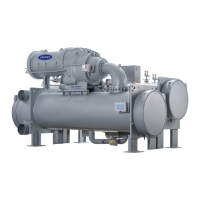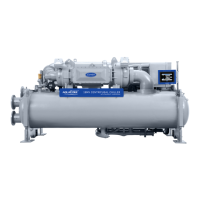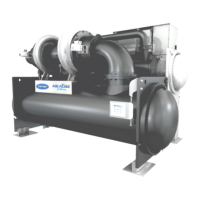33
Fig. 30 — Pressure Sensor Calibration Menu
INITIAL START-UP
Preparation —
Before starting the chiller, verify:
1. Power is on to the VFD, chiller control panel, water
pumps, and other equipment as required.
2. Cooling tower water is at proper level and at-or-below
design entering temperature.
3. Chiller is charged with refrigerant and all refrigerant
valves are in their proper operating positions.
4. Carrier inhibitor is located and available to be added
through evaporator charging valve.
5. Valves in the evaporator and condenser water circuits are
open and flow is as per design.
NOTE: If the pumps are not automatic, ensure water is
circulating properly.
6. Access the PUMPDOWN/LOCKOUT feature from the
Maintenance Menu. Press the End Lockout button on the
touch screen and accept the “press OK to Terminate
Lockout?” prompt. The unit is reset to operating mode.
The chiller is locked out at the factory in order to prevent
accidental start-up.
Check Motor Rotation
1. Close the starter enclosure door.
2. Apply 3-phase power to drive.
3. The VFD checks for proper phase rotation as soon as
power is applied to the starter and the PIC5 controls pow-
er up.
4. An alarm message will appear on the HMI screen if the
phase rotation is incorrect. If this occurs reverse any 2 of
the 3 incoming power leads to the starter and reapply
power. The motor is now ready for a rotation check.
5. Go to Main Menu, Quick Test and Enable Quick Test fol-
lowing by enable Motor Rotation Check. This starts the
following sequence:
a. Fully open the first IGV.
b. Open evaporator control valve, condenser drain
valve, close condenser control valve, and evaporator
control valve. Run refrigerant pump for 30 seconds.
c. Start the motor and ramp to 5 Hz in 10 seconds.
d. Once the motor speed reaches 5 Hz, stop motor.
e. Stop refrigerant pump 1 minute after motor speed
reaches 5 Hz, then reset all 4 refrigerant lubrication
valves to close.
f. Three minutes after motor speed reaches 5 Hz,
close first IGV.
Status can be followed in Quick test as Check State
IDLE=0, PreLub=1, Rotat=2, PosLub=3, End=4.
6. When the VFD is energized and the motor begins to turn,
check for clockwise motor rotation through first stage
sight glasses. See Fig. 31.
Fig. 31 — Correct Motor Rotation
Check Refrigerant Lube
1. In Quick Test the refrigerant lube pressure can be
checked. Open Evaporator CV, then run the refrigerant
pump. Pressure drop across the refrigerant pump must
exceed 8 psig (55 kPa). If pressure drop is negative,
check the pump rotation. If pressure drop is below 8 psig
(55 kPa), check for clogged filter drier or bearing supply
filter.
2. Press the Stop button and listen for any unusual sounds
from the compressor as it coasts to a stop.
To Prevent Accidental Start-Up — A chiller STOP
override setting may be entered to prevent accidental start-up
during service or whenever necessary. From the Main Menu,
access the General Parameters Menu and use the down arrow
to reach Stop Override on the GENUNIT table. Change Stop
Override to Yes; then execute the command by touching the
lightning button. The message “ALM-276 Protective Limit -
Stop Override” will appear in the Home Screen message area.
To restart the chiller, access the same screen and change the
Stop Override option to No.
Check Chiller Operating Condition — Check to be
sure that chiller temperatures, pressures, water flows, and re-
frigerant levels indicate the system is functioning properly.
Instruct the Customer Operator — Ensure the op-
erator(s) understand all operating and maintenance procedures.
Point out the various chiller parts and explain their function as
part of the complete system.
CAUTION
Do not permit water or brine that is warmer than 150°F
(65°C) to flow through the cooler or condenser. Refrigerant
overpressure may discharge through the relief device and
result in the loss of refrigerant charge (applicable only with
standard CLT rupture disk).
IMPORTANT: Do not check motor rotation during coast-
down. Rotation may have reversed during equalization of
vessel pressures.
CORRECT MOTOR ROTATION
IS CLOCKWISE WHEN VIEWED
THROUGH SUCTION PIPE
LEADING TO COMPRESSOR
1ST STAGE SIGHT GLASS

